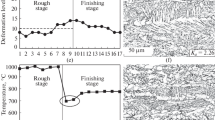Conclusion
With the stipulated amount (10–15%) of martensitic phase, smaller ferrite grain size, and a smaller amount of extracted nonmetallic inclusions we obtain the optimal combination of strength and technological ductility of cold rolled sheet steels. This is a substantiation of the technological ways of ensuring further improvement of stampability of low alloy steels with increased strength.
Similar content being viewed by others
Literature cited
A. A. Vostrikov, V. V. Gaiduk, and G. É. Arkulis, "A new indicator of stampability," Stal', No. 1, 67–71 (1981).
A. G. Ovchinnikov, Progressive Technological Processes of Cold Forging [in Russian], Mashinostroenie, Moscow (1985).
V. K. Belosevich, M. L. Drobinskii, and O. N. Yakubovskii, "Pressing of car body parts from new sheet steel with increased strength," Avtomobil'naya Promyshlennost', No. 4, 24–25 (1983).
S. A. Golovanenko and N. M. Fonshtein, "A new class of materials: ferritic-martensitic steels with high stampability," Stal' No. 7, 615–620 (1980).
S. A. Golovanenko and N. M. Fonshtein, "Structural biphase steels," in: Achievements of Science and Technology. Metal Science and Heat Treatment, Vol. 17, VINITI, Moscow (1983), pp. 64–120.
A. N. Bortsov and N. M. Fonshtein, "The effect of carbon concentration on the mechanical properties of low carbon low alloy ferritic-martensitic steels," Fiz. Met. Metalloved.,54, No. 4, 782–787 (1984).
C. L. Magee, R. G. Davies, and P. Beardmore, J. Met.,32, No. 11, 28–35 (1980).
N. M. Fonshtein, M. L. Drobinskii, L. M. Bulgakova, et al., "The effect of the initial structure on the structure and properties of cold-rolled steel quenched in the α+γ− range,", Stal', No. 2, 73–76 (1985).
W. B. Hutchinson, "Dual-phase steels. Deep-drawing characteristics," Experimental Ind., No. 6, 502–505 (1983).
Additional information
Translated from Metallovedenie i Termicheskaya Obrabotka Metallov, No. 9, pp. 5–8, September, 1986.
Rights and permissions
About this article
Cite this article
Fonshtein, N.M., Skorokhodova, L.G., Yakubovskii, O.N. et al. Effect of the structure of indices of technological ductility of cold-rolled low-alloy steels with improved strength. Met Sci Heat Treat 28, 625–628 (1986). https://doi.org/10.1007/BF00742738
Issue Date:
DOI: https://doi.org/10.1007/BF00742738




